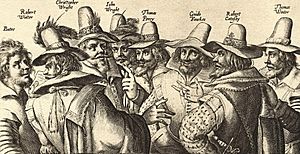Van de Passe family facts for kids
The van de Passe or de Passe family was a group of Dutch artists. They were famous for making engravings. An engraving is a picture made by carving lines into a metal plate, which is then used to print images. This family was like a dynasty, meaning many family members were artists, starting with Crispijn the Elder.
They were similar to other famous artist families like the Wierix family. However, the van de Passe family often made more everyday commercial art. Most of their engravings were portraits of people, title pages for books, and similar items. They made fewer large, detailed story pictures.
It can be hard to tell their artworks apart because their styles were very similar. Many family members also created their own designs, and some of their drawings still exist today.
Crispijn the Elder: The Family's Start
Crispijn de Passe the Elder was born around 1564 in a place called Arnemuiden in the Netherlands. He passed away in Utrecht in 1637. He was a publisher and an engraver.
Crispijn started his training in 1580 in Antwerp. At that time, Antwerp was a very important center for making prints. Many busy art workshops there created artworks for publishers. These publishers had great ways to send their art all over Europe.
In 1584, Crispijn became a member of Antwerp's artists' Guild of Saint Luke. He also worked for a well-known publishing house called Plantin Press.

Crispijn mainly copied designs made by other Antwerp artists, especially Maerten de Vos. Maerten de Vos was a very busy designer of prints. Crispijn van de Passe married Magdalena de Bock, who was a niece of de Vos's wife.
Life was difficult for many artists during the Dutch Revolt. This was a time of big changes and conflicts in the Netherlands. Because of his religious beliefs, Crispijn de Passe had to move often to stay safe. He first went to Aachen, but then had to leave there too.
In 1589, he started his own engraving and publishing business in Cologne. But he was forced to leave again in 1611. Around 1612, he set up his business in Utrecht. Here, he made engravings for people in England and other countries.
Crispijn died in Utrecht in 1637. His artworks include a famous picture of the English Gunpowder Plotters. This picture shows people who tried to blow up the Parliament building. We don't know how he got the exact likenesses of these people.
You can find the family's prints in many art collections. This includes the National Portrait Gallery in London.
The Second Generation: Following in Their Father's Footsteps

Four of Crispijn the Elder's children also became important engravers. They worked for the family business. Even his grandson, Crispijn III, became an engraver.
His oldest son, Simon de Passe (born around 1595), worked in England starting around 1616. Later, in 1624, he moved to Copenhagen. There, he became the royal engraver and designed medals for the king. He stayed there until he passed away in 1647. Simon is best known for an early print he made in London of Pocahontas in 1616.
Crispijn II (born around 1597) worked in different cities. He was in Paris from at least 1617 to 1627. Then he worked in Utrecht from 1630 to 1639. After that, he moved to Amsterdam and stayed there until he died around 1670. One of his best works is for a book called "Maneige royal." This book gave instructions to the king on how to ride a horse.
Willem de Passe (born around 1598) was the least active of the siblings. He took over from his brother in England, probably after working in France. He died in London around 1637. He joined a church called the Huguenot church in 1624.
Magdalena van de Passe (born 1600) was also an engraver. She was born in Cologne and died in Utrecht in 1638. She was especially good at engraving landscapes. After she married another artist in 1634, she mostly stopped making engravings. Her husband passed away in 1636. The family business likely involved sending drawings, engraved metal plates, and printed copies all over Europe.
After three family members passed away between 1637 and 1638, only Crispijn II in the Netherlands and Simon in Denmark remained active. Crispijn II's later years were not very successful. Crispijn III was a less important artist who died in 1678.
Major Works by the Family
The van de Passe family created many important works. Here are a few examples:
- Hortus Floridus: This was a famous book about flowers. Most of the engravings in it were made by Crispijn II.
- Heroologia Anglica: This book was published in 1620. It contained sixty-five portraits of important English people. Various members of the family contributed to this work.

